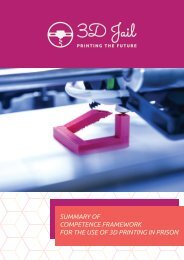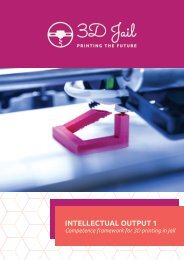Training models for the use of 3D printing technology in prison
3D Jail project further involves a training program for the training and development of trainers who are going to deliver the training program for inmates. Trainers are required to have basic computer, CAM and CAD skills. For the training of the trainers has also been planned an in-service training program to cover information on general characteristics of penitentiary institutions and inmates, use of the e-learning portal, and 3D printing.
3D Jail project further involves a training program for the training and development of trainers who
are going to deliver the training program for inmates. Trainers are required to have basic computer,
CAM and CAD skills. For the training of the trainers has also been planned an in-service training
program to cover information on general characteristics of penitentiary institutions and inmates, use
of the e-learning portal, and 3D printing.
You also want an ePaper? Increase the reach of your titles
YUMPU automatically turns print PDFs into web optimized ePapers that Google loves.
3D Modeling
3D Printing
Improvement
Introduction
The Intellectual Output 1 - the first phase of the development of the 3D-Jail project - was dedicated to
investigate the current use of 3D technology in European prisons in order to assess which procedures
have already achieved successfully and providing a basis for a meaningful assessment in the second
phase of the project to create a training model suitable for several European countries.
Partners have shown that there are regulations and practices regarding the use of 2D/Digital-
Graphic/Online Media content for prisoners in all partner countries. There are also examples of using
3D technologies in Belgium, Greece and Italy. An overview of these practices, though limited in
number, shows that relevant projects focus on 3D design and manufacturing, aim to help prisoners to
improve design skills and creativity and develop problem-solving skills.
Partner countries give importance to training programs and courses to integrate prisoners
within society during and after imprisonment, and that both e-learning and face-to-face classes are
used to deliver training programs.
The term 3D printing covers a variety of processes in which material is joined or solidified under
computer control to create a three-dimensional object, with material being added together. The
process of 3D printing consists of designing an object via CAD-Software, slicing the object using CAM
software, and then printing the object. Post processing may be needed depending on the printing
technology used.
The software for 3D printing – both on CAD and CAM – is versatile enough to support a broad
field of applications, therefore they can be used efficiently for all kind of different approaches and
needs.
Thus, 3D printing (or manufacturing) mainly comprises three steps:
Creating models
using CAD or similar
3D modeling
software, and saving
them in STL format
The designed 3D object
is printed layer by layer
using such techniques
as plastics melting,
laser sintering and
stereolithography.
A final touch is
required to clean,
improve or smooth
the surface of critical
objects.
What are possible field of the application of 3D technologies in prisons?
● Designing items and pieces using CAD software: This part of the program provides the inmates
with other added qualifications that can be useful to get prepared for potential jobs related
to design of materials, or even to start a business.
● 3D-printing of non-technical, or technical parts that are used in the industrial production, or
printing items for the social good: the former makes possible to develop ideas at a faster pace,
and this can help companies to reduce manufacturing time from months to days, while
ensuring that they remain ahead of their competitors. The latter may be, for example, printing
of low-cost customized prosthetic limbs, for those who are in need and cannot pay for
expensive bionic parts.
At the end of IO1 research, the competences required from trainers and inmates to use 3D
technologies were defined to create training paths appropriately for participants.
3DJail printing the future – IO2
2





